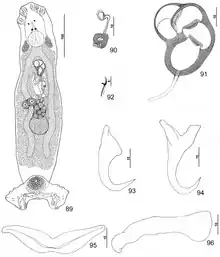Pseudorhabdosynochus vascellum
Pseudorhabdosynochus vascellum is a diplectanid monogenean parasitic on the gills of the scamp, Mycteroperca phenax. It has been described by Kritsky, Bakenhaster and Adams in 2015.[1]
| Pseudorhabdosynochus vascellum | |
|---|---|
 | |
| Body and sclerotised parts | |
| Scientific classification | |
| Domain: | Eukaryota |
| Kingdom: | Animalia |
| Phylum: | Platyhelminthes |
| Class: | Monogenea |
| Order: | Dactylogyridea |
| Family: | Diplectanidae |
| Genus: | Pseudorhabdosynochus |
| Species: | P. vascellum |
| Binomial name | |
| Pseudorhabdosynochus vascellum Kritsky, Bakenhaster & Adams, 2015 | |
Description
Pseudorhabdosynochus vascellum is a small monogenean. The species has the general characteristics of other species of Pseudorhabdosynochus, with a flat body and a posterior haptor, which is the organ by which the monogenean attaches itself to the gill of is host. The haptor bears two squamodiscs, one ventral and one dorsal. The sclerotized male copulatory organ, or "quadriloculate organ", has the shape of a bean with four internal chambers, as in other species of Pseudorhabdosynochus.[2] The vagina includes a sclerotized part, which is a complex structure.
Etymology
The specific name (a noun) is from Latin (vascellum = a small vessel) and refers to the small chamber of the vaginal sclerite.[1]
Diagnosis
Kritsky, Bakenhaster & Adams (2015) wrote that Pseudorhabdosynochus vascellum belongs to the group of species of Pseudorhabdosynochus parasitizing groupers assigned to Mycteroperca and characterized by having a distally reflexed tube and a single chamber in the vaginal sclerite. The group includes P. kritskyi, P. capurroi, P. vascellum, P. contubernalis, P. hyphessometochus, and P. mycteropercae. Except for P. hyphessometochus, P. vascellum is easily distinguished from these species by its small thick-walled chamber of the vaginal sclerite having a meager cavity. Pseudorhabdosynochus hyphessometochus also possesses a vaginal sclerite with a thick wall of the chamber, but the cavity of the chamber in this species is comparatively large. Pseudorhabdosynochus vascellum is probably closest morphologically to P. contubernalis by possessing a delicate, almost nonexistent cone of the male copulatory organ.[1]
Hosts and localities
_NOAA.jpg.webp)
The type-host and only recorded host of Pseudorhabdosynochus vascellum is the scamp, Mycteroperca phenax (Serranidae: Epinephelinae). The type-locality, and only known locality, is Pinnacles Reef System, off Mississippi Sound, South of Pascagoula, Mississippi.[1]
References
- Kritsky, Delane C.; Bakenhaster, Micah D.; Adams, Douglas H. (2015). "Pseudorhabdosynochus species (Monogenoidea, Diplectanidae) parasitizing groupers (Serranidae, Epinephelinae, Epinephelini) in the western Atlantic Ocean and adjacent waters, with descriptions of 13 new species". Parasite. 22: 24. doi:10.1051/parasite/2015024. ISSN 1776-1042. PMC 4536336. PMID 26272242.

- Kritsky, D. C. & Beverley-Burton, M. 1986: The status of Pseudorhabdosynochus Yamaguti, 1958, and Cycloplectanum Oliver, 1968 (Monogenea: Diplectanidae). Proceedings of the Biological Society of Washington, 99, 17-20. PDF
